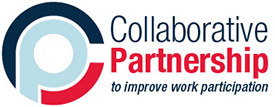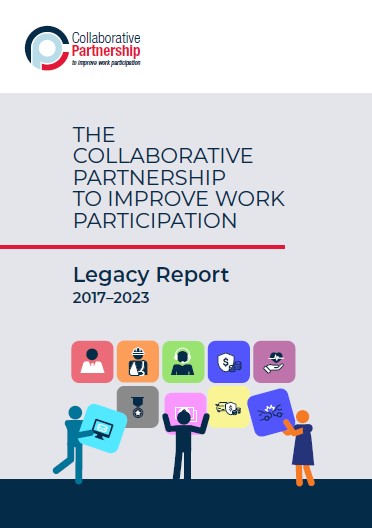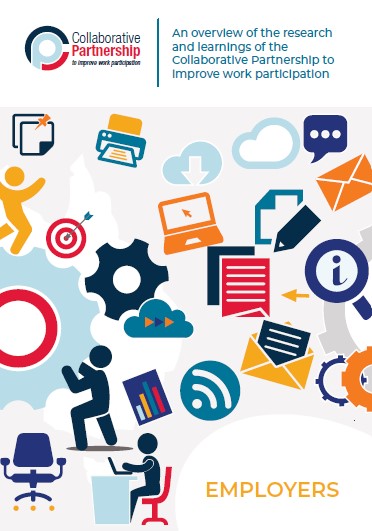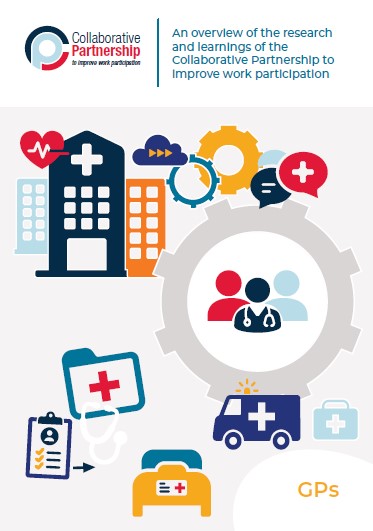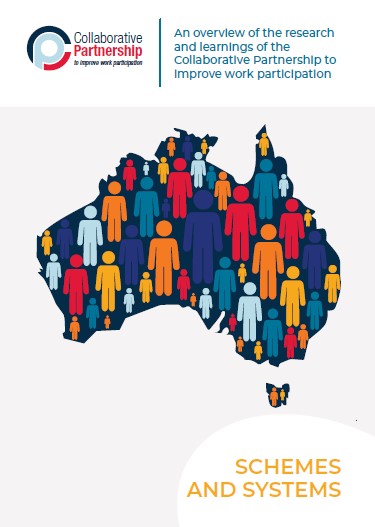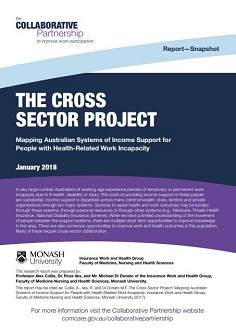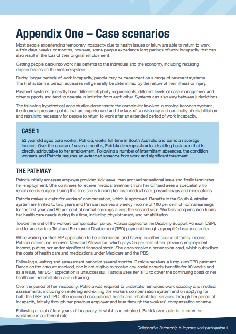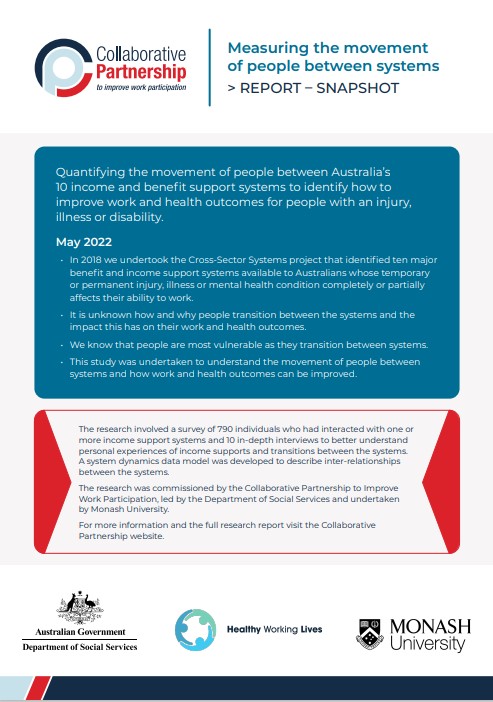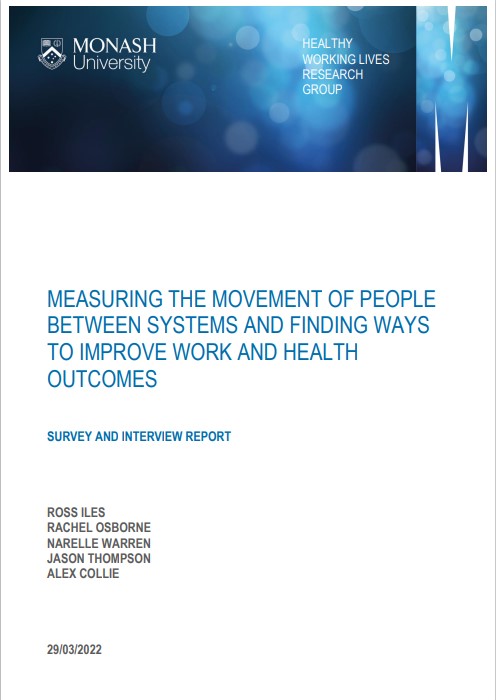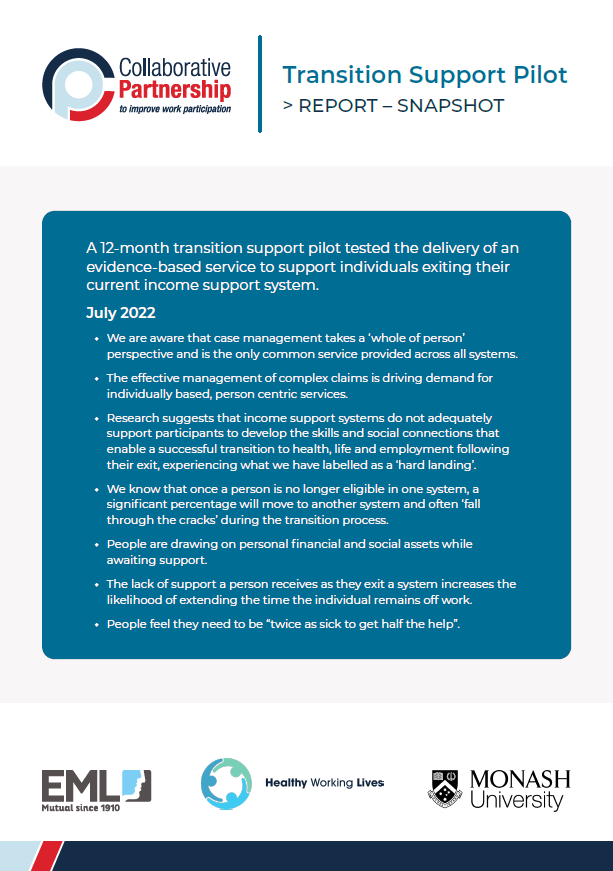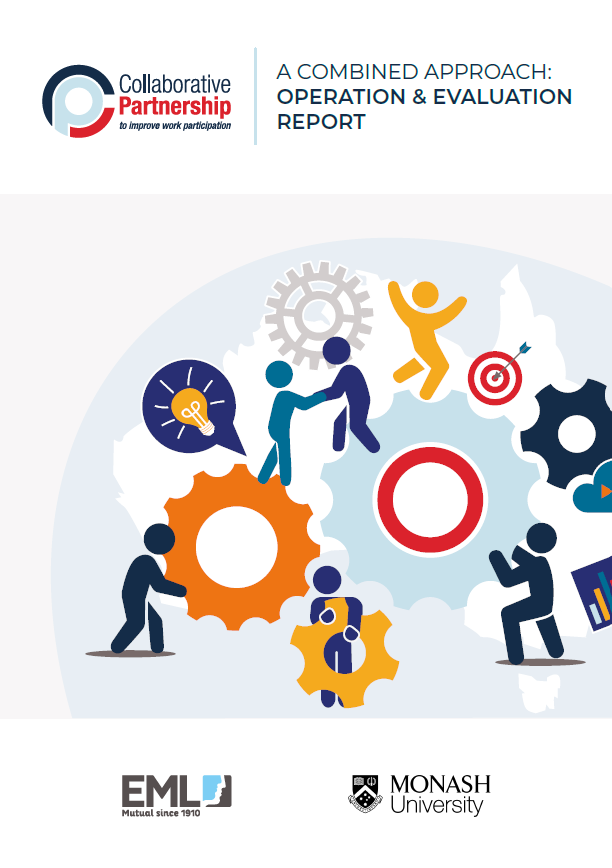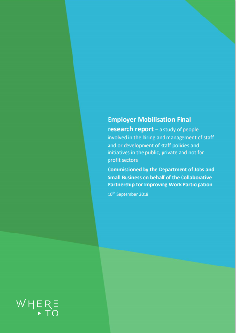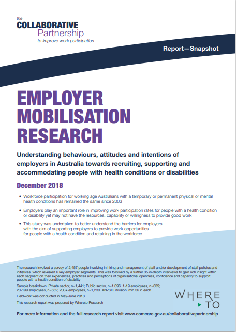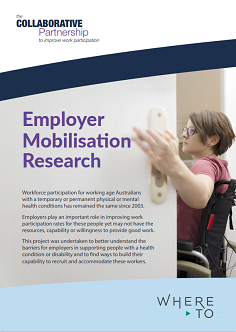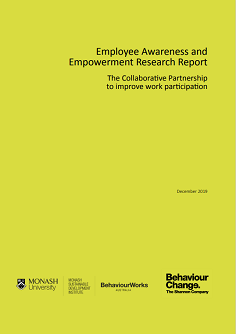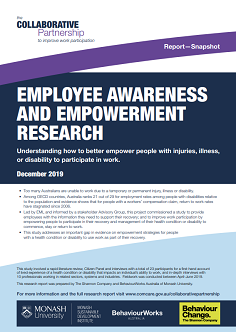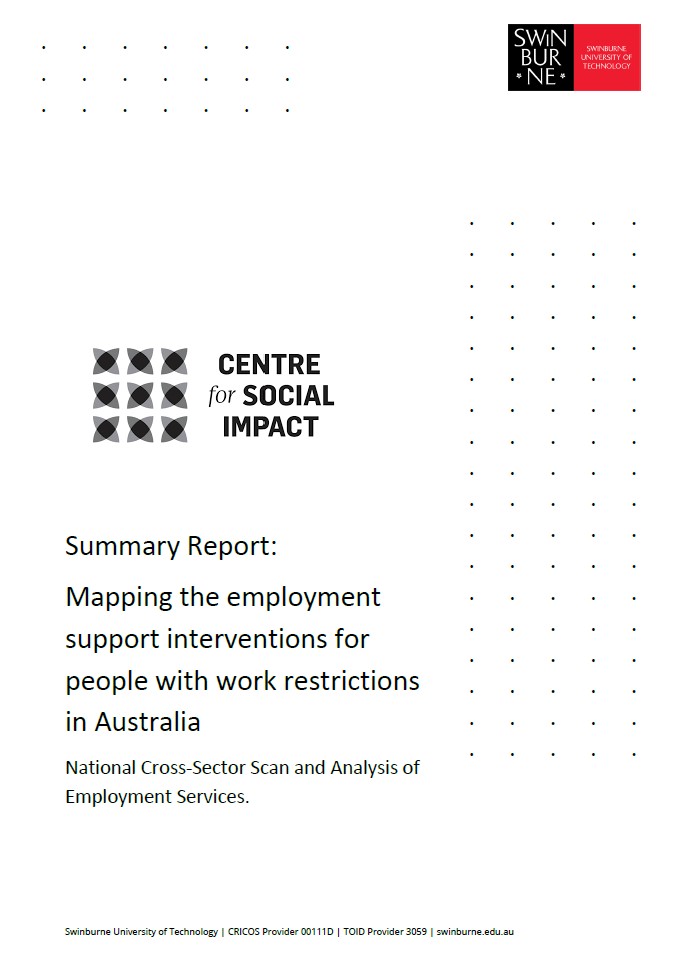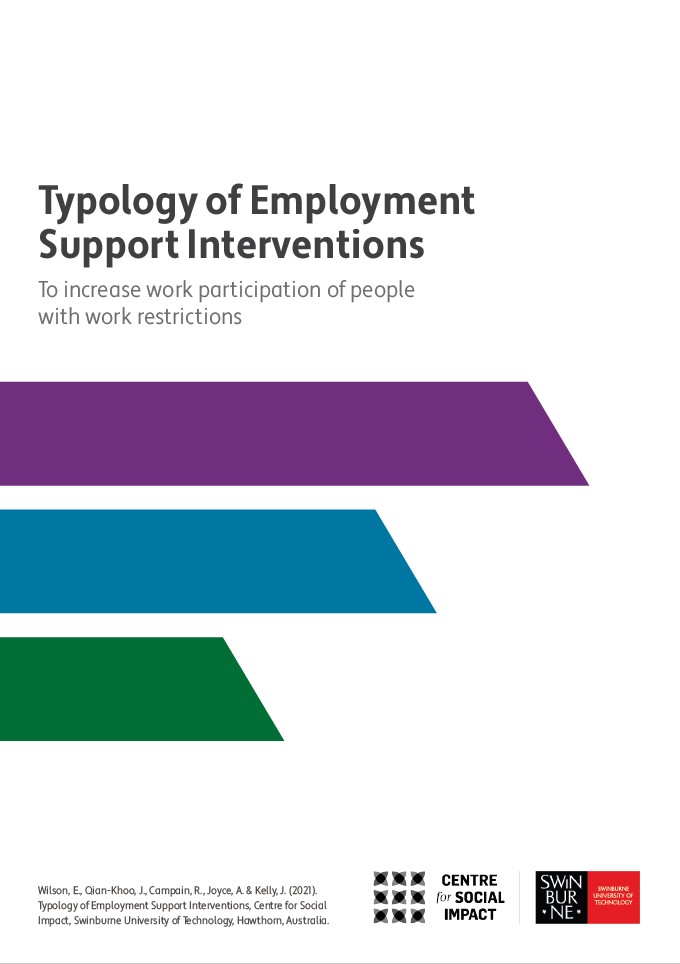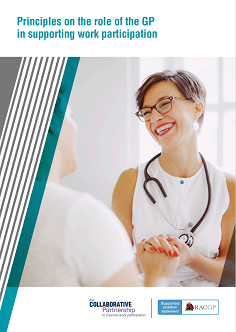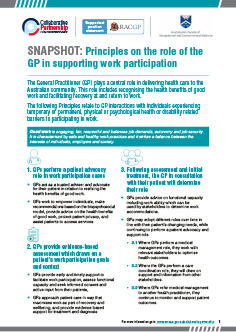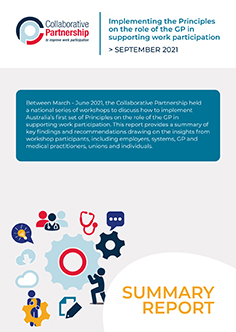Resources
Together we have delivered new insights, evidence and outputs to inform our thinking and future work.
Read about the Collaborative Partnership’s past projects and research publications.
Legacy and Research Reports
Legacy report
This report provides an overview of the Collaborative Partnership, why it existed, who was involved and what it achieved. The report provides the key learnings from the extensive research and work undertaken by the Partnership and its members.
Research reports
These reports provide a comprehensive look at the research undertaken by the Collaborative Partnership and collated into single reports on each topic.
Schemes and Systems
Cross-Sector Systems Project
We developed the first conceptual map of Australia’s ten major benefit and income support systems that are used by people who are unable to work due to a health condition or disability.
The project identified how each system connects, interacts and operates. It also outlines opportunities to achieve better work and health outcomes for people with a health condition or disability.
Key findings
- Systems are complex, fragmented and highly disparate.
- People are most vulnerable when they transition between systems.
- Case management is the one service common to all systems.
- 786,000 people were unable to work due to ill health, injury or disability received income support.
- $37.2B was spent on income support for these people during one year (15/16).
Measuring the movement of people between systems
We surveyed 790 individuals to better understand personal experiences of income supports and transitions between systems.
This project was undertaken to understand the movement of people between systems and how work and health outcomes can be improved for people with an injury, illness or disability. The project also identified the relationship between systems.
Key findings
- People interact with different systems concurrently or back and forth until ‘landing’ in their current system of income support.
- A single transition between systems can take months, is highly stressful and often involves long periods of no income.
- People most commonly interacted with one system of income and benefit support.
- Centrelink is the most commonly used income support system.
- 30% of people engaged with two systems.
Supporting people moving between systems
We trialled a 12-month Transition Support Pilot to test the delivery of an evidence-based service to support individuals exiting their current income and benefit support system.
EML provided the Transition Support Pilot to 50 injured workers with long-duration workers’ compensation claims exiting the Victorian Workers’ Compensation system. The project identified recommendations for future transition support programs.
An evaluation of WorkSafe Victoria’s Transition Support Program is available on ISCRR's Clearinghouse.
Key findings
- 48% of participants reported a positive change to their general physical health and mental health.
- The timing of the service was identified as the most important component.
- 94% of participants requires support to access health and community services.
- Almost all participants had a desire to be working, not just for the financial benefits but for the purpose that employment brings.
Employers and Workplaces
Employer Mobilisation Project
We surveyed almost 2,500 employers about their attitudes and behaviours and undertook 35 in-depth interviews to gain rich insight into employer’s experiences, confidence and capacity to support people with a health condition or disability.
This project involved two phases: quantitative and qualitative research and an evidence review of empowerment interventions. This project explored the behaviours, attitudes and intentions of employers towards hiring and supporting people with a health condition or disability.
Key findings
- Employers with experience in hiring or supporting people with health conditions or disability are more likely to repeat the experience.
- 50% of employers are not confident in their businesses ability to support people with a physical or psychological disability or health condition.
- 53% of employers believe their workplace culture is not supportive of people with a physical or psychological disability or health condition.
Employee Awareness Project
We undertook a rapid literature review, Citizen Panel and interviews with 23 participants on their firsthand account of lived experience of a health condition or disability that impacts their ability to work.
This project explored how to better empower people with a health condition or disability to use work as part of their recovery. The project explored the attitudes and needs of people with lived experience to determine how they navigated Australia’s benefit and income support systems, and their interactions with health providers and employers. The project also interviewed 10 professionals working in related sectors, systems and industries.
Key findings
- “You need to make yourself look twice as bad in order to get half the help you need.”
- Employers play a pivotal role in people trying to stay at work.
- The best opportunities for empowerment include dependent self-empowerment (for the individual) and dependent empowerment (change external to the individual).
National cross-sector scan and analysis of employment services
We conducted a national scan and analysis to map the employment support interventions available for people with work restrictions in Australia.
The project provides insights into how Australia’s major benefit and income support systems use and engage with the policies and programs of services that support people with a health condition or disability to participate in good work and identifies the best opportunities for alignment across services, sectors and systems.
An original Typology of Employment Support Interventions was developed as part of the project, a guide to the typology is available here.
The Typology
- The typology contains three segments characterised by common purposes and underlying paradigms that inform understanding of work restriction and approaches to employment support provision. These include:
- Segment 1: Injury and compensation segment
- Segment 2: Commonwealth labour market program segment
- Segment 3: Disability-specific segment
- The typology identified two levels of eligibility to employment supports, these are:
- Eligibility to the ‘system’ ie. workers compensation, motor vehicle accident compensation.
- Eligibility to employment supports within the systems.
Providers
GP Support Project
We developed Australia’s first national Principles on the role of General Practitioners (GPs) in supporting work participation.
The Principles on the role of General Practitioners (GPs) in supporting work participation provide clarity around roles and expectations of stakeholders involved in supporting work engagement, recovery at and return to good work.
The Principles are a starting point for GPs, other relevant professionals and stakeholders to work better together to ensure no Australians are disadvantaged due to a health condition or disability that may impact their ability to work.
Key findings
- The General Practitioner (GP) plays a central role in the delivery of health care to the Australian community.
- The role of the GP in treating and supporting individuals with an injury, illness or disability, and their responsibilities in determining capacity for work can be complex and challenging.
- GPs are well placed to guide and educate their patients on the health benefits of good work.
- Good work is engaging, fair, respectful and balances job demands, autonomy and job security.
Read about the Health Benefits of Good Work TM an initiative from our partner, the Australasian Faculty of Occupational and Environmental Medicine (AFOEM) here.
